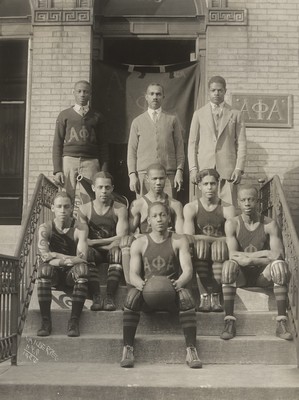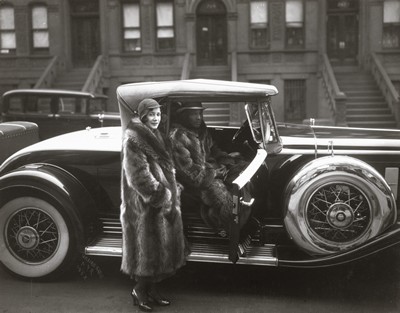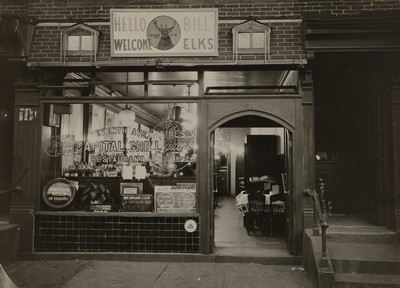James Van Der Zee's Photographs
Portraits of Harlem
National Gallery of Art, Washington
November 28, 2021 – May 30, 2022
Alpha Phi Alpha Basketball Team, 1926
Gelatin silver print
Image/sheet: 23.34 x 17.94 cm (9 3/16 x 7 1/16 in.)
National Gallery of Art, Washington, Corcoran Collection
(The Evans-Tibbs Collection, Gift of Thurlow Evans Tibbs, Jr.)
2015.19.4507
© 1969 Van Der Zee
Couple, Harlem, 1932, printed 1974
Gelatin silver print
Image/sheet: 18.2 x 23.8 cm (7 3/16 x 9 3/8 in.)
Mount: 38.1 x 31.7 cm (15 x 12 1/2 in.)
National Gallery of Art, Washington,
Alfred H. Moses and Fern M. Schad Fund
2021.22.1.16
© 1969 Van Der Zee
Photographer JAMES VAN DER ZEE (1886–1983) created an extraordinary chronicle of Black life in New York City’s Harlem neighborhood during the first half of the 20th century. James Van Der Zee’s Photographs: A Portrait of Harlem presents some 40 works from the National Gallery’s collection, providing a window into life in the historic neighborhood during the Harlem Renaissance and beyond. Harlem residents flocked to James Van Der Zee’s studio to mark milestones in their lives, posing for portraits against elaborate backdrops. The exhibition highlights these portraits, as well as photographs of the community, revealing how James Van Der Zee’s pictures, and the photographer himself, played a formative role in the community life of Harlem.
The exhibition includes several recently acquired works on view for the first time. The selection includes examples from across James Van Der Zee’s photographic career in Harlem, from a range of studio portraits and photographs of religious, social, and athletic community groups to images of Harlem storefronts and examples from his time serving as an official photographer for Marcus Garvey’s Universal Negro Improvement Association.
“James Van Der Zee’s photographs are essential records of a neighborhood that has had an enormous influence on American culture. His images provide an insider’s view of the community that formed Harlem—its spiritual leaders, political activists, and creatives, as well as its mothers, fathers, sons, and daughters,” said Kaywin Feldman, director, National Gallery of Art. "Thanks to many recent acquisitions, the National Gallery now holds a substantial collection of Van Der Zee’s photographs and we are honored to be able to share his work with our audiences.”
Capital Grill Restaurant, c. 1940
gelatin silver print
National Gallery of Art, Washington, Avalon Fund
2019.127.12
© 1969 Van Der Zee
Soldier, 1944
gelatin silver print
National Gallery of Art, Washington, Avalon Fund
2019.127.13
© 1969 Van Der Zee
Within a decade of moving to Harlem around 1905, James Van Der Zee was making portraits such as the stylish half-length Portrait of a Woman (1914), which is seen at the beginning of James Van Der Zee’s Photographs: A Portrait of Harlem. By the late 1910s James Van Der Zee opened his own photography studio, where he catered to the growing Harlem population, home to African Americans who moved north during the Great Migration as well as Black immigrants from Caribbean nations. James Van Der Zee took particular care in composing his studio photographs—he offered clients the choice of cosmopolitan painted backdrops, an extensive collection of props, and polished wardrobe options for their pictures, as evident in studio portraits such as Portrait of a Couple (1924), Portrait of a Young Woman (1930), and A Casual Affair (1932). He also used techniques of manipulation, including subtle retouching, vivid hand-coloring, and even etching onto the negative to give the illusion of additional jewelry, seen, for example, in the teardrop necklace on the subject of "Beautiful Bride" (c. 1930).
James Van Der Zee actively photographed the Harlem community beyond his studio walls. His street scenes documented the neighborhood’s vibrant commercial enterprises, such as The Avenue Fish Market (1938) and Capital Grill Restaurant (c. 1940), as well as centers of Harlem nightlife like the Club Lido (1930s). James Van Der Zee was also commissioned by local professional, social, political, and spiritual organizations. In group portraits such as Alpha Phi Alpha Basketball Team (1926), Group Portrait, Church of God, Harlem (1933), and Uniform Rank of the Black Knights of Pythias (1926), James Van Der Zee infused his photographs of Black collectives with a sense of pride, elegance, and self-possession.
The exhibition closes with selections from the 1974 portfolio that brought together new prints of negatives from James Van Der Zee’s photographic career after his work was rediscovered for the Metropolitan Museum of Art’s 1969 exhibition, Harlem on My Mind. Though controversial for excluding African American painters and sculptors while focusing exclusively on the social history of the neighborhood, the exhibition nevertheless brought James Van Der Zee’s work to public attention late in his life. Featuring some of James Van Der Zee’s best-known photographs, such as Couple, Harlem (1932), it also includes some of James Van Der Zee’s earliest work prior to his move to Harlem and photographs he made for Marcus Garvey and the Universal Negro Improvement Association.
The exhibition is organized by the National Gallery of Art and curated by Diane Waggoner, curator of 19th-century photographs, National Gallery of Art.
NATIONAL GALLERY OF ART
West Building, Ground Floor, Gallery 22
6th St and Constitution Ave NW, Washington DC




